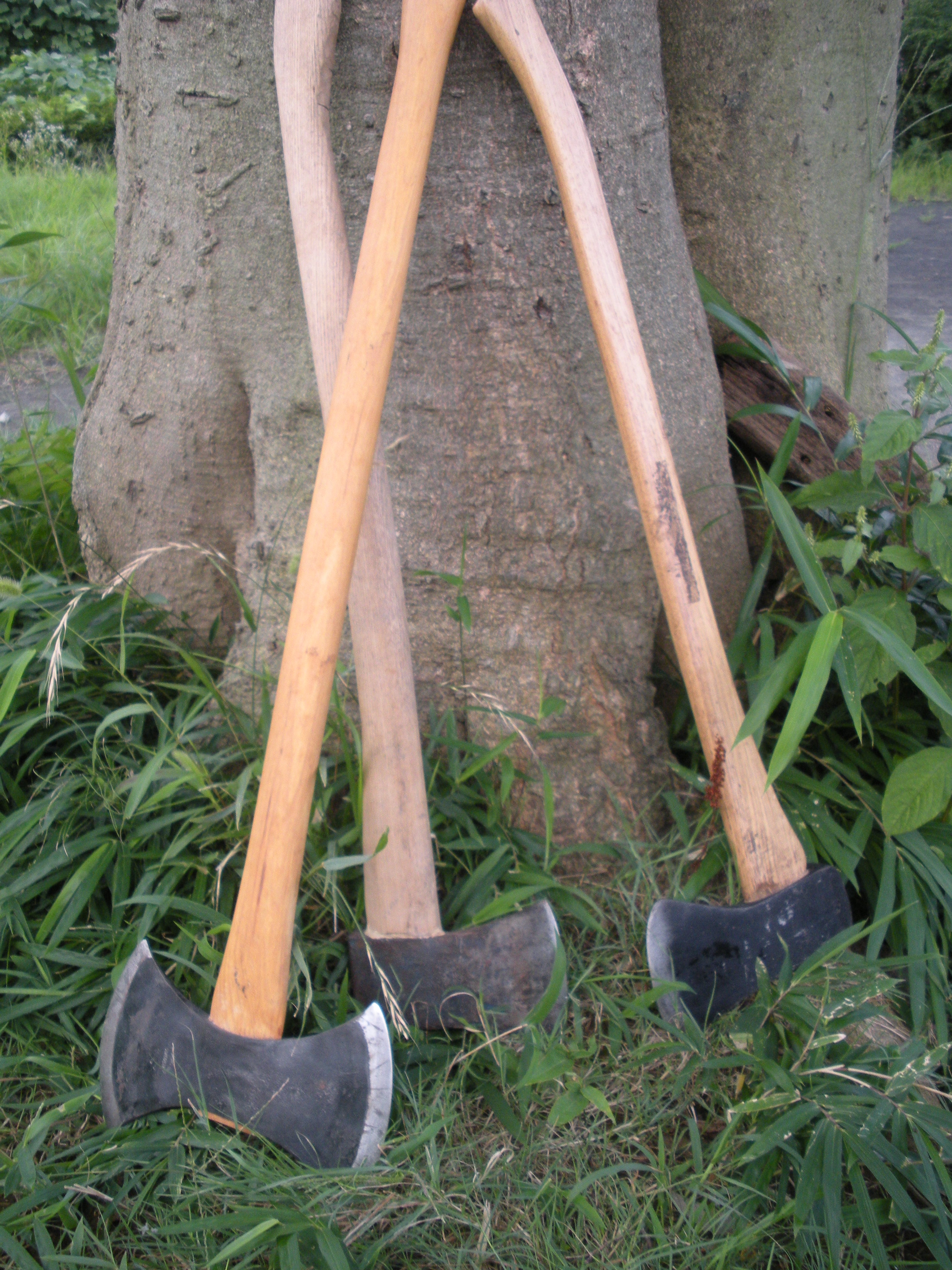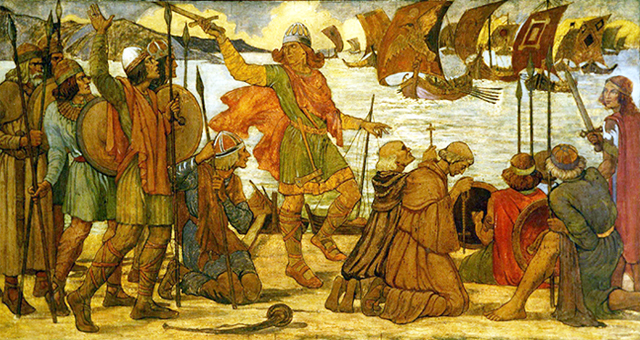|
Bearded Axe
A bearded axe, or Skeggøx (from Old Norse ''Skegg'', "beard", and ''øx'', "axe"), is any of various axes, used as a tool and weapon, as early as the 6th century AD. It is most commonly associated with Viking Age Scandinavians. The hook or "beard", i.e. the lower portion of the axe bit extending the cutting edge below the width of the butt, provides a wide cutting surface while keeping the overall mass of the axe low. This design allows the user to grip the haft directly behind the head for planing or shaving wood and variations of this design are still in use by modern woodworkers and some foresters. The "beard" of the axe would also have been useful in battle, for example to pull a weapon or shield out of a defender's grasp. There are a number of variants in its design.Jan Petersen"De Norske Vikingesverd" ''Internet Archive Org Page 38'', 1919 See also * Viking Age arms and armor *Viking axe The Dane axe is an ... [...More Info...] [...Related Items...] OR: [Wikipedia] [Google] [Baidu] |
Axe Of Iron From Swedish Iron Age, Found At Gotland, Sweden
An axe ( sometimes ax in American English; American and British English spelling differences#Miscellaneous spelling differences, see spelling differences) is an implement that has been used for Millennium, millennia to Wood carving, shape, Wood splitting, split and Woodchopping, cut wood, to harvest Lumber, timber, as a battle axe, weapon, and as a ceremony, ceremonial or Heraldry, heraldic symbol. The axe has many forms and specialised uses but generally consists of an axe head with a Handle (grip), handle, or ''helve''. Before the modern axe, the Stone Age, stone-age hand axe without a handle was used from 1.5 million years Before Present, BP. Hafted axes (those with a handle) date only from 6000 BC. The earliest examples of handled axes have heads of rock (geology), stone with some form of wooden handle attached (hafting, hafted) in a method to suit the available materials and use. Axes made of copper, bronze, iron and steel appeared as these technologies developed. The ... [...More Info...] [...Related Items...] OR: [Wikipedia] [Google] [Baidu] |
Old Norse
Old Norse, Old Nordic, or Old Scandinavian, is a stage of development of North Germanic languages, North Germanic dialects before their final divergence into separate Nordic languages. Old Norse was spoken by inhabitants of Scandinavia and their Viking expansion, overseas settlements and chronologically coincides with the Viking Age, the Christianization of Scandinavia and the consolidation of Scandinavian kingdoms from about the 7th to the 15th centuries. The Proto-Norse language developed into Old Norse by the 8th century, and Old Norse began to develop into the modern North Germanic languages in the mid-to-late 14th century, ending the language phase known as Old Norse. These dates, however, are not absolute, since written Old Norse is found well into the 15th century. Old Norse was divided into three dialects: Old West Norse, ''Old West Norse'' or ''Old West Nordic'' (often referred to as ''Old Norse''), Old East Norse, ''Old East Norse'' or ''Old East Nordic'', and ''Ol ... [...More Info...] [...Related Items...] OR: [Wikipedia] [Google] [Baidu] |
Viking Age
The Viking Age () was the period during the Middle Ages when Norsemen known as Vikings undertook large-scale raiding, colonizing, conquest, and trading throughout Europe and reached North America. It followed the Migration Period The Migration Period was a period in European history marked by large-scale migrations that saw the fall of the Western Roman Empire and subsequent settlement of its former territories by various tribes, and the establishment of the post-Roman ... and the Germanic Iron Age. The Viking Age applies not only to their homeland of Scandinavia but also to any place significantly settled by North Germanic peoples, Scandinavians during the period. The Scandinavians of the Viking Age are often referred to as ''Vikings'' as well as ''Norsemen'', although few of them were Vikings in sense of being engaged in piracy. Voyaging by sea from their homelands in Denmark, Norway, and Sweden, the Norse people settled in the Viking activity in the British Is ... [...More Info...] [...Related Items...] OR: [Wikipedia] [Google] [Baidu] |
Scandinavia
Scandinavia; Sámi languages: /. ( ) is a subregion in Northern Europe, with strong historical, cultural, and linguistic ties between its constituent peoples. In English usage, ''Scandinavia'' most commonly refers to Denmark, Norway, and Sweden. It can sometimes also refer more narrowly to the Scandinavian Peninsula (which excludes Denmark but includes part of Finland), or more broadly to include all of Finland, Iceland, and the Faroe Islands. The geography of the region is varied, from the Norwegian fjords in the west and Scandinavian mountains covering parts of Norway and Sweden, to the low and flat areas of Denmark in the south, as well as archipelagos and lakes in the east. Most of the population in the region live in the more temperate southern regions, with the northern parts having long, cold, winters. The region became notable during the Viking Age, when Scandinavian peoples participated in large scale raiding, conquest, colonization and trading mostly throughout Eu ... [...More Info...] [...Related Items...] OR: [Wikipedia] [Google] [Baidu] |
Japanese Bearded Axe, Held
Japanese may refer to: * Something from or related to Japan, an island country in East Asia * Japanese language, spoken mainly in Japan * Japanese people, the ethnic group that identifies with Japan through ancestry or culture ** Japanese diaspora, Japanese emigrants and their descendants around the world * Japanese citizens, nationals of Japan under Japanese nationality law ** Foreign-born Japanese, naturalized citizens of Japan * Japanese writing system, consisting of kanji and kana * Japanese cuisine, the food and food culture of Japan See also * List of Japanese people * * Japonica (other) * Japonicum * Japonicus * Japanese studies Japanese studies ( Japanese: ) or Japan studies (sometimes Japanology in Europe), is a sub-field of area studies or East Asian studies involved in social sciences and humanities research on Japan. It incorporates fields such as the study of Japane ... {{disambiguation Language and nationality disambiguation pages ... [...More Info...] [...Related Items...] OR: [Wikipedia] [Google] [Baidu] |
Viking Age Arms And Armor
Knowledge about military technology of the Viking Age (late 8th to mid-11th century Europe) is based on relatively sparse archaeological finds, pictorial representation, and to some extent on the accounts in the Norse sagas and laws recorded in the 14th century. According to custom, all free Norse men were required to own weapons, and permitted to carry them at all times. Indeed, the ''Hávamál'', purported to be sage advice given by Odin, states "Don't leave your weapons lying about behind your back in a field; you never know when you may need all of sudden your spear." As war was the most prestigious activity in Viking Age Scandinavia, beautifully finished weapons were an important way for a warrior to display his wealth and status. A wealthy Viking would likely have a complete ensemble of a spear, a wooden shield, and either a battle axe or a sword. Battle axes were considered the "normal weapon" for middle class Vikings. Swords were normally reserved for upper class and nobl ... [...More Info...] [...Related Items...] OR: [Wikipedia] [Google] [Baidu] |
Viking Axe
The Dane axe is an early type of battle axe, primarily used during the transition between the European Viking Age and early Middle Ages. Other names for the weapon include English long axe, Danish axe, and hafted axe. Construction Most axes, both in period illustrations and extant artifact, that fall under the description of Danish axe possess type L or type M heads according to the Petersen axe typology. Both types consist of a wide, thin blade, with pronounced "horns" at both the toe and heel of the bit. Cutting surfaces vary, but is generally between . Type L blades tend to be smaller, with the toe of the bit swept forward for superior shearing capability. Later type M blades are typically larger overall, with a more symmetrical toe and heel. The blade itself was reasonably light and forged very thin, making it superb for cutting. The thickness of the body on top the edge is as thin as 2 mm. Many of these axes were constructed with a reinforced bit, typically of a highe ... [...More Info...] [...Related Items...] OR: [Wikipedia] [Google] [Baidu] |
Axes
Axes, plural of '' axe'' and of '' axis'', may refer to * ''Axes'' (album), a 2005 rock album by the British band Electrelane * a possibly still empty plot (graphics) A plot is a graphical technique for representing a data set, usually as a graph showing the relationship between two or more variables. The plot can be drawn by hand or by a computer. In the past, sometimes mechanical or electronic plotters were ... See also * Axess (other) * Axxess (other) {{disambig ... [...More Info...] [...Related Items...] OR: [Wikipedia] [Google] [Baidu] |
Medieval Blade Weapons
In the history of Europe, the Middle Ages or medieval period lasted approximately from the late 5th to the late 15th centuries, similar to the post-classical period of global history. It began with the fall of the Western Roman Empire and transitioned into the Renaissance and the Age of Discovery. The Middle Ages is the middle period of the three traditional divisions of Western history: classical antiquity, the medieval period, and the modern period. The medieval period is itself subdivided into the Early, High, and Late Middle Ages. Population decline, counterurbanisation, the collapse of centralized authority, invasions, and mass migrations of tribes, which had begun in late antiquity, continued into the Early Middle Ages. The large-scale movements of the Migration Period, including various Germanic peoples, formed new kingdoms in what remained of the Western Roman Empire. In the 7th century, North Africa and the Middle East—most recently part of the Eastern Rom ... [...More Info...] [...Related Items...] OR: [Wikipedia] [Google] [Baidu] |
Viking Warfare
Vikings ; non, víkingr is the modern name given to seafaring people originally from Scandinavia (present-day Denmark, Norway and Sweden), who from the late 8th to the late 11th centuries raided, pirated, traded and settled throughout parts of Europe.Roesdahl, pp. 9–22. They also voyaged as far as the Mediterranean, North Africa, Volga Bulgaria, the Middle East, and North America. In some of the countries they raided and settled in, this period is popularly known as the Viking Age, and the term "Viking" also commonly includes the inhabitants of the Scandinavian homelands as a collective whole. The Vikings had a profound impact on the early medieval history of Scandinavia, the British Isles, France, Estonia, and Kievan Rus'. Expert sailors and navigators aboard their characteristic longships, Vikings established Norse settlements and governments in the British Isles, the Faroe Islands, Iceland, Greenland, Normandy, and the Baltic coast, as well as a ... [...More Info...] [...Related Items...] OR: [Wikipedia] [Google] [Baidu] |








